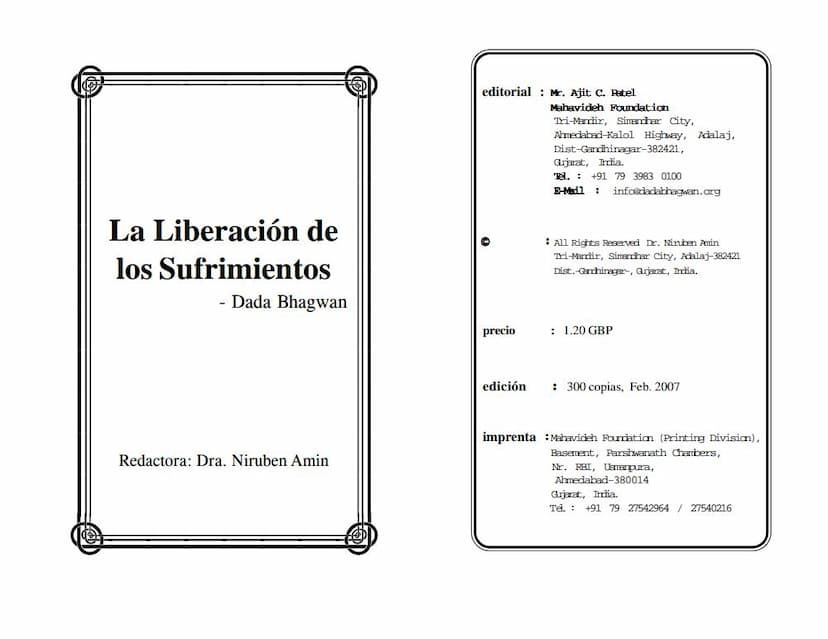La Culpa Es Del Que Sufre In Spanish Language
Added to library: September 2, 2025

Summary
Here's a comprehensive summary of the Jain text "La Culpa Es Del Que Sufre" (The Fault is of the Sufferer) by Dada Bhagwan, based on the provided pages:
This book, published by Mahavideh Foundation, expounds on a core teaching of Dada Bhagwan, a Gnani Purush (Self-Realized Being), which is central to his path of Akram Vignan (the "shorter, elevator path" to Self-Realization). The central tenet is encapsulated in the phrase: "The fault is of the sufferer."
Introduction to Dada Bhagwan and Akram Vignan:
- Dada Bhagwan, also known as Ambalal M. Patel, experienced spontaneous Self-Realization in 1958. This event dissolved his ego, and he became an instrument for the liberation of others, identifying the divine presence within him as "Dada Bhagwan." He taught that this same divine Self resides within everyone, but is fully manifested within him.
- Akram Vignan is presented as a scientific approach to Self-Realization that bypasses the traditional step-by-step spiritual progression. It's described as an "elevator path" or a shortcut to experiencing the Self.
- Dada Bhagwan developed a scientific process called the Gnan Vidhi (Divine Grace) to impart this knowledge and the experience of the Self to others in a short period (around two hours).
- After Dada Bhagwan left his physical body in 1988, Dr. Niruben Amin continued his work, and after her passing in 2006, Shri Deepakbhai Desai became the instrument for carrying on the mission and conducting satsangs and Gnan Vidhis.
The Core Teaching: "The Fault is of the Sufferer":
- Natural Justice vs. Worldly Justice: The book distinguishes between the illusory justice of the world (which perpetuates suffering) and the immutable justice of Nature. The fundamental law of Nature is that "the fault is of the sufferer."
- Understanding Suffering: Suffering arises from our own faults. We are bound by our past actions (karma). Liberation comes when these faults are destroyed. The book explains that by mistakenly identifying as the doer of actions (ego-centric view), we remain bound to our faults.
- Who is Guilty?: The book argues that when an incident occurs, the person who experiences suffering is the one who is truly at fault in the eyes of Nature's justice. The apparent "doer" of the harm is often just an instrument, and their own faults will catch up with them later.
- Example: If a servant breaks valuable cups, and the master suffers, the master is the one at fault for experiencing the suffering. The servant will face consequences when their own faults are revealed.
- Example: If someone steals your wallet, and you suffer from the loss, you are considered at fault for the suffering. The thief will face consequences when apprehended for their actions.
- The Nature of Karma: Suffering is not random; it's the result of past karmic accounts being settled. Enjoyment comes from meritorious deeds. The law of Nature is exact and unfailingly apportons consequences.
- Overcoming Suffering: The book advocates for acceptance and understanding rather than mere tolerance. Tolerance requires immense energy and is limited, whereas understanding through Gnan provides permanent freedom from suffering.
- The Role of the Gnani: The knowledge of the Self (Atmagnan) is not found in books but in the heart of a Gnani. A Gnani Purush, through the Akram Vignan method, can help one realize this truth.
- Applying the Principle: The core principle of "the fault is of the sufferer" should be applied to all life situations. By recognizing our own suffering as a consequence of our own past faults, we stop blaming others, which in turn prevents the creation of new karmic accounts and breaks the cycle of suffering.
- Intellect vs. Gnan: Being affected by bad news or worldly events is a sign of intellect (which leads to emotions and worries). True Gnan (absolute knowledge) allows one to remain calm and observant, unaffected by external events.
- No External Fault: No one in the world can truly harm you unless it is a consequence of your own past faults. Everyone else is merely an instrument in the unfolding of your karma.
- Practical Application: People are encouraged to write this maxim in their homes and apply it to daily occurrences, such as cooking accidents or disagreements. The person who shows distress or suffering is the one who is at fault.
- Internal Enemies: Internal enemies like anger, pride, greed, and attachment make us see faults in others. A Self-realized being, free from these, does not see faults in others.
- Personal Responsibility: Ultimately, you are solely responsible for your life and your suffering. God does not intervene in the settling of karmic accounts.
- The Computer Analogy: Nature's justice system is compared to an infallible computer, unlike human-made computers which can err. This natural justice is free from attachment and bias.
Key Takeaways:
- Liberation from suffering is achievable by understanding and applying the principle that "the fault is of the sufferer."
- This understanding eliminates the need to blame others, which is the root cause of further suffering.
- Akram Vignan and the Gnan Vidhi offered by Dada Bhagwan provide a direct path to this realization.
- True spiritual progress lies in self-awareness and the acceptance of one's own karmic accountability, rather than seeking external justice.
The book emphasizes that this is a profound science, universally applicable, and the key to achieving true liberation from the cycle of suffering and rebirth.